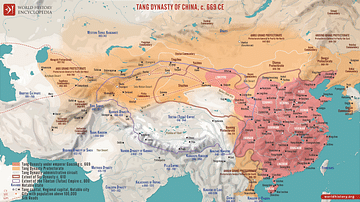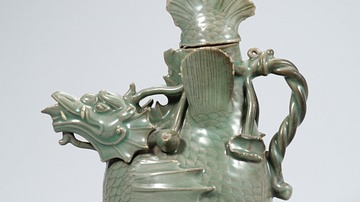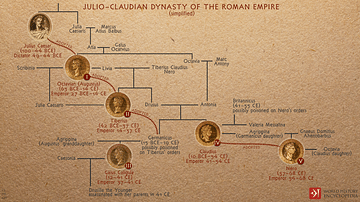Search
Search Results

Image
Shang Dynasty of China, c. 1100 BCE
This map illustrates the rise and expansion of the Shang dynasty, which emerged around 1600 BCE after the fall of the Xia dynasty. Centered on the North China Plain, the Shang established a hereditary monarchy with a centralized government...

Image
Tang Dynasty of China, c. 669 CE
A map illustrating the Tang Dynasty of China at its greatest extent under the rule of Emperor Gaozong, encompassing modern-day China, parts of Central Asia, and the Korean Peninsula. Around 669, the Empire reached its pinnacle of economic...

Image
Family Tree of the Ptolemaic Dynasty of Egypt (305-30 BCE)
This infographic illustrates the royal lineage of the Ptolemaic Dynasty, which ruled Egypt during the Hellenistic period (305–30 BCE). Founded by Ptolemy I Soter, a companion of Alexander the Great, the dynasty is notable for elevating royal...

Image
The Merovingian Dynasty, c. 639
This map illustrates the rise and expansion of the Merovingians, a Frankish dynasty that, by the late 5th century, unified the fragmented tribes of present-day France, Germany, the Low Countries, Switzerland, and Austria. Beginning with Clovis...

Image
Celadon Fish-Dragon Ewer, Goryeo Dynasty
A celadon fish-dragon ewer. 12th century CE, Goryeo Dynasty, Korea. (National Museum of Korea, Soul, South Korea)

Image
Liao Dynasty Map
A map indicating the territory controlled by the Liao dynasty (Khitans), 907-1125 CE.

Image
Delhi Sultanate under the Mamluk Dynasty, 1206-1290
This map illustrates the foundation and expansion of the Delhi Sultanate under the Mamluk Dynasty (also spelled Mameluke, Arabic: مملوك, mamlūk, meaning "one who is owned," a slave), which ruled northern India from 1206 to 1290. Established...

Image
The Barcid Dynasty of Carthage
This infographic illustrates the rise and influence of the Barcid Dynasty, a powerful Carthaginian family that shaped Carthage’s military and political strategy during the third century BCE. Active from circa 260 to 200 BCE, the Barcids played...

Image
Julio-Claudian Dynasty of the Roman Empire
A depiction of the evolution of the first imperial dynasty of ancient Rome, the Julio-Claudians that began with Augustus (Julius Caesar's adopted son) and included the reigns of Tiberius, Caligula, Claudius, and Nero. During their time, Rome...

Image
Tang Dynasty Provinces c. 742 CE
The provinces of the Tang Dynasty c. 742 CE. The Tang Dynasty (618-907 CE) is regularly cited as the greatest imperial dynasty in ancient Chinese history. It was a golden age of reform and cultural advancement, which lay the groundwork for...